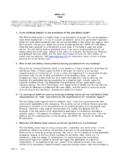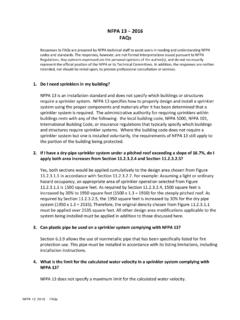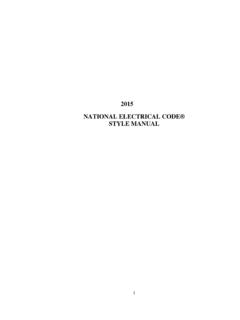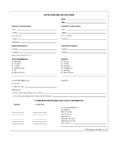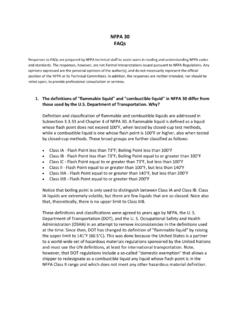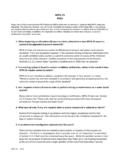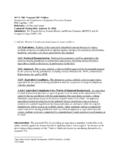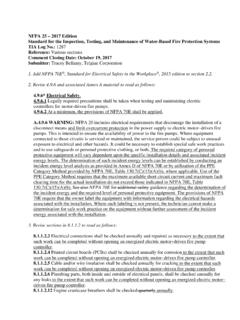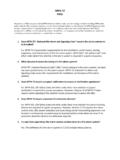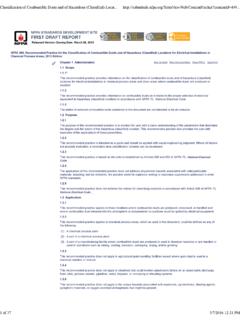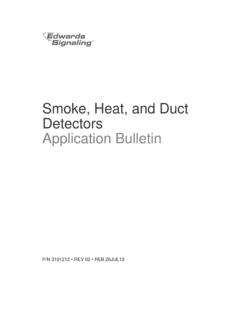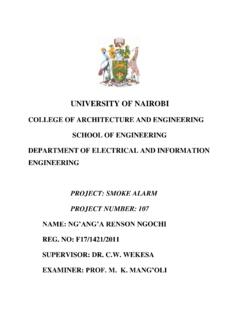Transcription of Smoke Detector Spacing for High Ceiling Spaces
1 2017 Fire Protection Research Foundation 1 Batterymarch Park, Quincy, MA 02169-7417, USA Email: | Web: Smoke Detector Spacing for high Ceiling Spaces FINAL REPORT BY: Robert Accosta Jr., Drew Martin Arup USA, Inc. New York, NY, USA October 2017 Page ii Page iii FOREWORD NFPA 72, National Fire Alarm and Signaling Code, does not address Spacing consideration for Smoke detection based on Ceiling heights. However, there is a table that allows for reduction of Spacing for heat detection. There has been confusion in design and code enforcement on what to do when Smoke detectors are installed on higher ceilings.
2 There is a need for clarification on how to apply Smoke detection Spacing requirements. To provide guidance, the Technical Committee needs additional information on the impact of Ceiling height and Detector Spacing on Smoke detection performance. The Research Foundation initiated this project to review available literature and standards and perform a gap analysis related to the impact of Ceiling height and Detector Spacing on Smoke detection performance to inform the NFPA 72 Technical Committee. The Fire Protection Research Foundation expresses gratitude to the report authors Robert Accosta Jr.
3 , , and Drew Martin, who are with Arup USA, Inc. located in New York, NY, USA. The Research Foundation appreciates the guidance provided by the Project Technical Panelists, the funding provided by the project sponsors, and all others that contributed to this research effort. The content, opinions and conclusions contained in this report are solely those of the authors and do not necessarily represent the views of the Fire Protection Research Foundation, NFPA, Technical Panel or Sponsors. The Foundation makes no guaranty or warranty as to the accuracy or completeness of any information published herein.
4 About the Fire Protection Research Foundation The Fire Protection Research Foundation plans, manages, and communicates research on a broad range of fire safety issues in collaboration with scientists and laboratories around the world. The Foundation is an affiliate of NFPA. About the National Fire Protection Association (NFPA) Founded in 1896, NFPA is a global, nonprofit organization devoted to eliminating death, injury, property and economic loss due to fire, electrical and related hazards. The association delivers information and knowledge through more than 300 consensus codes and standards, research, training, education, outreach and advocacy; and by partnering with others who share an interest in furthering the NFPA mission.
5 All NFPA codes and standards can be viewed online for free. NFPA's membership totals more than 65,000 individuals around the world. Keywords: Smoke detection, NFPA 72, high ceilings, Smoke Detector Spacing Page iv Report number: FPRF-2017-20 Page v Page vi PROJECT TECHNICAL PANEL Shane Clary, Bay Alarm Tom Cleary, NIST Fred Leber, LRI Dave Mills, UL (Alternate: Pravin Gandhi, UL) Lynn Nielson, City of Henderson Jason Webb, AFAA Barry Chase, NFPA Staff Liaison Dick Roux, NFPA Staff Liaison PROJECT SPONSORS Honeywell NEMA 3SB Siemens Johnson Controls Wagner Fire Safety Page vii Fire Protection Research Foundation Smoke Detector Spacing for high Ceiling Spaces Final Report Issue | October 6, 2017 This report takes into account the particular instructions and requirements of our client.
6 It is not intended for and should not be relied upon by any third party and no responsibility is undertaken to any third party. Job number 256171-00 Arup USA, Inc. 77 Water Street New York, NY 10005 United States of America Fire Protection Research Foundation Smoke Detector Spacing for high Ceiling Spaces Final Report | Issue | October 6, 2017 | Arup USA, Inc. \\ \AMERICAS\JOBS\N-Y\250000\256171-00\4 INTERNAL PROJECT DATA\4-05 REPORTS & NARRATIVES\ Contents Page Executive Summary 1 1 Review of Relevant NFPA 72 Requirements 3 NFPA 72 Heat Detection Requirements 3 NFPA 72 Smoke Detection Requirements 5 2 Review of Relevant Literature 7 Overview of Global Codes & Standards 7 Overview of Key Literature 10 Key Variables Affecting Detector Performance 17 3 Review of Test Data 18 Fire Tests 18 Fire Modeling 32 4 Gaps 49 Available Data 50 Smoke Detector Sensitivity 50 Ionization & photoelectric Detector Smoke
7 Entry Characteristics 51 Temperature Gradient 51 Ceiling Surface 52 Airflows 52 Performance Metric 52 5 Research Plan & Next Steps 53 Research 55 6 Discussion & Conclusion 57 Work Cited 58 Appendices Appendix A Compendium of Related Sources Fire Protection Research Foundation Smoke Detector Spacing for high Ceiling Spaces Final Report | Issue | October 6, 2017 | Arup USA, Inc. \\ \AMERICAS\JOBS\N-Y\250000\256171-00\4 INTERNAL PROJECT DATA\4-05 REPORTS & NARRATIVES\ Page 1 Executive Summary NFPA 72, National Fire Alarm and Signaling Code, sets forth requirements for the application, installation, performance and inspection/testing/maintenance of fire alarm and emergency communications systems as well as their related components.
8 As part of these requirements, NFPA 72 specifies location and Spacing criteria for Smoke detectors . Unlike the Spacing reduction for heat detectors that is required based on Ceiling height, NFPA 72 does not address Spacing considerations for Smoke detectors based on Ceiling height. There is inconsistency in design and code enforcement for Spacing requirements of Smoke detectors when installed in areas with high ceilings, where high ceilings are defined as over 10 feet in height. Clarification is required in NFPA 72 on how to apply Smoke detection Spacing requirements for these high Ceiling applications.
9 To assist in justifying the code change (as applicable), the NFPA 72 technical committee needs additional information on the impact of Ceiling height and Detector Spacing on Smoke detection performance. Detection devices perform an important function by providing warning for building occupants so that they are aware of a fire in time to allow for safe egress; however, a performance metric for a significant fire challenge or an acceptable response time is not clearly defined in NFPA 72. The 30 foot ( meter) nominal Spacing currently used for Smoke Detector Spacing is defined by the NFPA 72 handbook as being.
10 Adequate to achieve the life safety objectives implied by the building , however the fire challenge(s) this protects is not explicitly defined. [1] There is a body of research, including standard fire tests, non-standard fire tests, and computer modelling, which have studied Smoke Detector performance in high Spaces (see Section ); however, the central problem is that it is difficult to achieve consistency in identifying the Smoke Detector performance. Smoke detectors are tested in accordance to ANSI/UL 268 Standard for Smoke detectors for Fire Alarm Systems, which specifies that sensitivity meet a minimum obscuration level measured using Smoke generated from either a smoldering cotton lamp wick or an aerosol generator.
